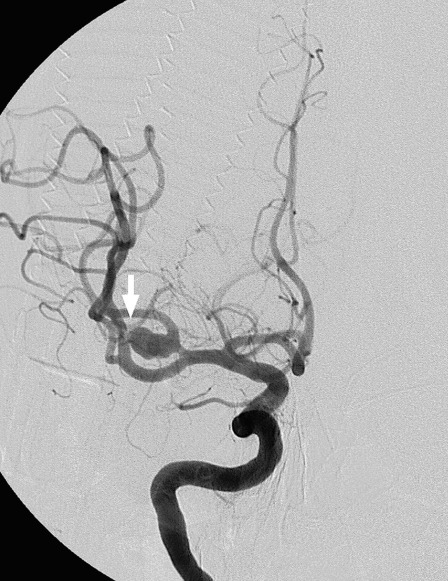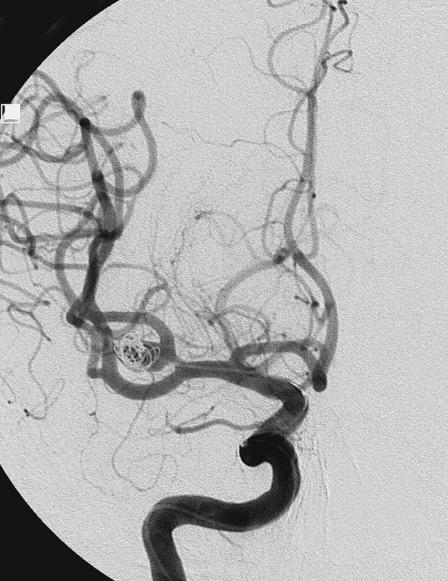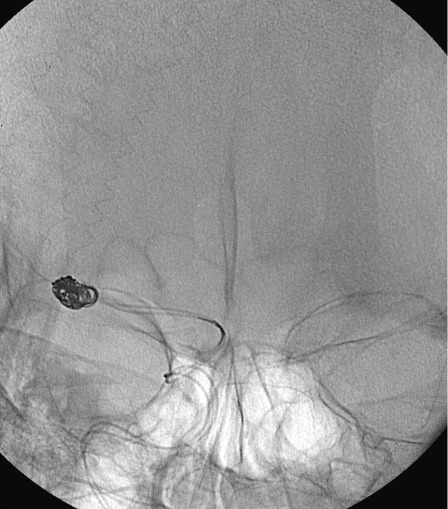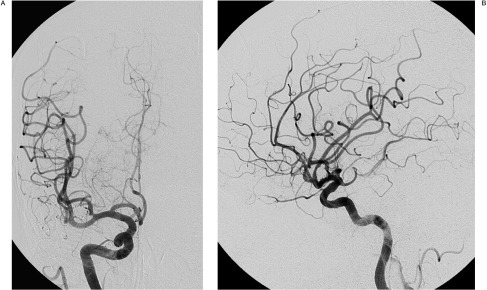Summary
We report a case of an elongated middle cerebral artery bifurcation aneurysm which was managed using an endovascular double catheter technique. After positioning two microcatheters, one at the distal dome and the other at the proximal dome, two coils were subsequently deployed through each microcatheter. We created a proximal supporting coil frame using one microcatheter and preserved the parent artery, and then deposited subsequent packing coils at the distal aneurysm sac region using the other microcatheter. The proximal framing coils did not detach prior to obtaining satisfactory aneurysm packing through the distally positioned microcatheter. This approach allowed for the proximal coil to be withdrawn if there was any evidence of the proximal coil frame changing shape or of parent artery protrusion. This double microcatheter technique provided safe and effective treatment of an elongated middle cerebral artery bifurcation aneurysm.
Key words: embolization technique, brain aneurysm, sah, double catheter
Introduction
Endovascular treatment of intracranial aneurysms appears to be a realistic alternative management strategy in terms of effectiveness and safety 1. The ultimate goal of such endovascular management is complete occlusion of the aneurysm without compromising the parent artery. The double catheter technique has been reported as effective for treating complex aneurysms 2-4. Here we report a case of an elongated middle cerebral artery bifurcation aneurysm successfully treated using a modified double catheter technique.
Case Report
A 56-year-old female presented with a Grade III subarachnoid hemorrhage relating to a ruptured aneurysm at the right middle cerebral bifurcation. The aneurysm measured 8 x 4 mm, was saccular and elongated in shape (dome-to-neck ratio = 2.9), and had an apical tear or site of presumed rupture clearly identifiable on the initial angiogram (Figure 1).
Figure 1.
Right internal carotid angiogram, anteroposterior view, showing a saccular and elongated aneurysm at the middle cerebral bifurcation. An apical tear or site of presumed rupture is noted (arrow).
Under general anesthesia, a 6F guiding catheter (Envoy; Cordis, Miami, FL) was positioned in the right internal carotid artery. A microcatheter (Prowler-14; Cordis, Miami, FL) was carefully advanced and positioned at the middle portion of the aneurysm, and a 7 mm x 21 cm coil (Trufill DCS OrbitTM, complex fill, Cordis, Miami, FL) was used as a framing coil. A satisfactory framing was not achieved using the first coil which was positioned at the distal 2/3 of the aneurysm. Before detachment, another microcatheter (Prowler-14; Cordis, Miami, FL) was carefully placed in the proximal portion of the aneurysm through the same guiding catheter. A 6 mm x 15 cm coil (Trufill DCS OrbitTM, complex standard, Cordis, Miami, FL) was deployed and a good proximal frame was created at the neck of the aneurysm without compromising the parent artery. The first coil positioned through the distal catheter was detached and three helical coils (26 cm total length) were subsequently inserted for complete packing of the aneurysm. The proximal coil could be repositioned if there was any evidence of movement of the proximal coil toward the parent artery.
The proximal coil was detached after angiography confirmed satisfactory aneurysm occlusion without compromising the parent artery. A total of 5000 IU heparin was used during the procedure. The patient recovered without any disability after treatment. The clinical course was uneventful until discharge.
Figure 2.
An initial 7 mm x 21 cm frame coil is positioned, and is partially placed within the distal region of the aneurysm sac.
Figure 3.
A second microcatheter is advanced and placed at the proximal portion of aneurysm, and an additional stable supporting coil frame covering the proximal covering neck of the aneurysm is created.
Discussion
Following the use of double catheters for wide-necked intracranial aneurysm embolization by Baxter et Al 2, various authors have reported using technically modified double catheter techniques 3,4. The double microcatheter technique has several technical advantages and is associated with a relatively low risk of thromboembolic complications compared to those of balloons or stents.
Figure 4.
A,B) Final angiograms, anteroposterior and lateral views, showing near complete aneurysm occlusion without compromising the parent artery.
The neck-to-dome ratio is one of the most important issues in successful aneurysm embolization. While endovascular treatment is not considered difficult for elongated aneurysms, it is technically challenging to create a good initial frame that covers the entire aneurysm. Although the technique of piecemeal pattern coiling using a single microcatheter for an elongated aneurysm is often used, problems with this approach include impingement of coil loops on the parent artery, remnant aneurysm sacs, and continuing communication with the parent vessel due to loose coil packing 5.
In the present case, the key technical modifications of the double catheter technique for elongated aneurysms were the creation of a relatively stable supporting coil frame covering the proximal aneurysm neck, and the placing of a coil loop at the distal remnant aneurysm sac using another microcatheter. We used a relatively soft coil at the dome of the aneurysm (Trufill DCS OrbitTM, complex fill, Cordis, Miami, FL) and a standard coil (Trufill DCS OrbitTM, complex standard, Cordis, Miami, FL) at the aneurysm neck.
This approach allowed for the proximal coil to be repositioned if there was any evidence of movement of the proximal coil toward the parent artery. We believe that if the proximal supporting coil frame is made appropriately, this approach is more effective and safer than conventional coil embolization.
This double catheter technique provides a novel method for treating elongated aneurysms that is technically simple and avoids the use of other devices.
Conclusions
Compared to other methods for treating elongated intracranial aneurysms, this modified double catheter technique is safe, effective, and not technically demanding.
References
- 1.International Subarachnoid Aneurysm Trial (ISAT) Collaborative Group. International Subarachnoid Aneurysm Trial (ISAT) of neurosurgical clipping versus endovascular coiling in 2134 patients with ruptured intracranial aneurysms: a randomized trial. Lancet. 2002;360:1267–1274. doi: 10.1016/s0140-6736(02)11314-6. [DOI] [PubMed] [Google Scholar]
- 2.Baxter BW, Rosso D, Lownie SP. Double microcatheter technique for detachable coil treatment of large, wide-necked intracranial aneurysms. Am J Neuroradiol. 1998;19:1176–1178. [PMC free article] [PubMed] [Google Scholar]
- 3.Kwon OK, Kim SH, Kwon BJ, et al. Endovascular treatment of wide-necked aneurysms by using two microrcatheters: Techniques and outcomes in 25 patients. Am J Neuroradiol. 2005;26:894–900. [PMC free article] [PubMed] [Google Scholar]
- 4.Shin YS, Kim DI, Lee SI, et al. The usefulness of the new double-catheter technique in the treatment of parent artery incorporated wide-necked aneurysm with Guglielmi detachable coils. Interventional Neuroradiology. 2000;6:61–64. doi: 10.1177/159101990000600107. [DOI] [PMC free article] [PubMed] [Google Scholar]
- 5.Park HK, Horowitz M, Jungreis C, et al. Periprocedural morbidity and mortality associated with endovascular treatment of intracranial aneurysms. Am J Neuroradiol. 2005;26:506–514. [PMC free article] [PubMed] [Google Scholar]






